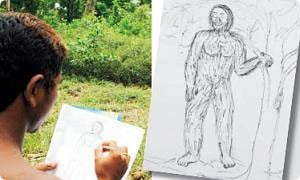With reference to yesterday’s blog, “Rival Group Claims ‘Johor Bigfoot’ Are Escaped Orangutans,”, here today for critique are the photographs and sketches that the API, SPI, Vincent Chow, and others feel are supportive of their theories. An even dozen different images are given for your insights.
First, you can see for the API analysis of this issue, they have used Cryptomundo’s Peter Loh drawing of the head of a Johor Mawas and positioned it next to a photograph of the head of an orangutan (Pongo pygmaeus). Their contention is that the Loh blue-tinted Mawas resembles the Indonesian mawas, the orangutan.

Of course, one of the major problems with the API theory is the upright nature of the reported Johor Mawas or Bigfoot, as shown here, from a local’s drawing of the often-encountered hairy bipedal hominoid.

The above sketch must be compared to the API’s photographs of the non-released members of the orangutan colony that were given by the late Sultan of Johor some 30 years ago to the Perth Zoo, at the same time other orangutans were allegedly released into the Johor jungles. These photographs are of contemporary members of the colony that would be about the same age as some members of the escapee survivors, if they exist.


On the following map, the red areas are Malaysian and the black ones are Indonesian. Peninsular Malaysia (i.e. where the State of Johor is located) is not known to have any orangutans (called mawas in Indonesia), as only Sumatra and Borneo have orangutans. The Malaysian Johor Bigfoot, Orang Lenggor, or Mawas are felt to be escaped orangutans by the API, but not by Dr. Vincent Chow and the SPI. The map more clearly shows the political divisions between the countries and the island versus mainland nature of the known orangutan existence versus the “Bigfoot” sightings.
Click on image for full-size version
Dr. Vincent Chow’s theory, of course, compares what he has seen in the unpublished photographs of the Johor Bigfoot, as shown in this drawing (and the one at the bottom of the page) by Peter Loh, with the reconstruction of Homo erectus, which have been found in fossil form throughout South Asia. The “Peking Man” and “Java Ape Man” – two early popularized names of Homo erectus – carry the strong association between Asia and the erectus hominids.


Another piece of evidence that may or may not have some impact is the footprint cast found in Johor. Does it have anything to say about the animal that made it? Is it from an ape? Is it a hoax? A natural depression in the ground extended by an animal stepping in a hole? Or an overlapping combination of two rhino tracks?

As news reporter Jan McGirk of The Independent has pondered, does this Johor track resemble the Bili Ape cryptid footprint cast found from Africa? Or does comparing it firmly put to rest the cryptid anthropoid nature of the Johor Mawas?

Above, in 2003, Shelly Williams displays for the media the cast of a track of the unknown ape, the so-called Bili Ape, found in Democratic Republic of Congo.

Are we, once again, left with more questions than answers?


I certainly appreciate the intellectual nature of our commentors, especially when you go all Gurdjieff on us and talk about “pouring from the empty into the void.”
We shall see what we shall see. Patience and passion.